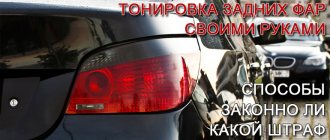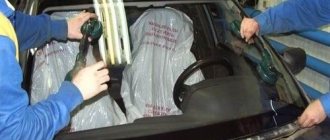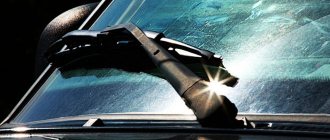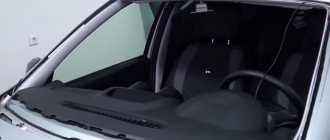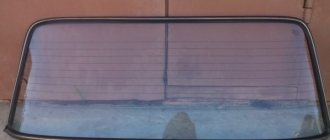Buying a car now is not too difficult - there are a variety of loans and installment payment programs. It is much more difficult to maintain it so that it is always in good working order, and its appearance remains the same as when it first left the point of sale. Regular washing of the car cannot completely solve all problems, because in addition to the body, the car has headlights, the cleanliness of which determines not only the appearance, but also traffic safety. Conventional washing does not allow you to completely get rid of the yellow coating that quickly appears on the glass during use. Polishing the headlights with toothpaste will help you quickly get them in order.
Why periodically polish
Optics in a car are very important, but headlights are constantly exposed to various influences - sand, gravel, dirt, stones flying out from under the wheels of other cars. In addition, various insects affect the optics. All this, sooner or later, can lead to the light losing its brightness and directionality. In addition, the car loses its appearance, presentability and attractiveness.
There is no way to avoid this. Therefore, periodic cleaning, polishing, and repair of the headlight is necessary. It is best to tidy up the optics yourself - this way you can save a considerable amount of money and time. Plastic headlights can become cloudy and deteriorate due to careless cleaning with a cloth. The cloth may not be soft or clean enough, or may have been saturated with some harmful detergent.
What is important to know
It's no secret that some even use sandpaper to restore the surface of the head or rear optics of a car. On Drive2 you can find many similar stories and instructions.
Car optics need constant protection from negative influences from the environment, roads and other road users. The outer surface is constantly exposed to dust, dirt, mechanical damage, chemicals, etc. To clean it and restore its previous transparency and light transmittance, you need to take an appropriate care and restoration kit. The market range is huge, which is why many cannot decide what is best for them to use.
Some people buy a special 3M type kit, which already contains everything needed for polishing. Others use toothpaste, others use goyim toothpaste, and still others buy branded products that have received the most positive reviews.
The price of pastes varies, as does their composition. It’s quite difficult to say unequivocally which one is the best. Some believe that only abrasive, and diamond, paste is suitable for such tasks. Others categorically refuse the idea of using any abrasive for fear of damaging the headlight material.
To make the right choice, you need to consider several points:
- Material of manufacture. Some compounds are intended only for glass headlights, others exclusively for plastic ones. But there are also universal solutions;
- Severity of damage. There are chips and deep scratches that pastes cannot save from. But there are also simply cloudings, yellowing, minor scratches and abrasions;
- Matching the specific headlight. If you can find out which polishing agents are suitable for your type of optics, that would be great.
The polishing process itself is done with your own hands or with a grinder. In the latter case, it is better to use a device in which the speed is regulated.
You can process glass headlights yourself without fear of any special consequences. But when working with plastic, it is better to contact a car service. The only downside is that the price of the service is quite high. Both in Minsk and in Moscow. But there is a minimum risk of harming the car. What do you think about this? Leave feedback.
Tools and materials
The standard polishing arsenal must include tools that can be used to remove the caps. You should also stock up on masking tape. To sand deep scratches, you need sandpaper with different grits. The maximum grit range should be from 600 to 4000. To complete this job as quickly as possible, a sander or any other power tool will come in handy. Naturally, polishing a headlight with toothpaste will not work without the toothpaste itself. Moisten the surface to be sanded with clean water and rinse it.
Polishing plastic headlights with toothpaste requires a foam sponge. Felt or felt is also perfect. If you don’t have any of this, then you can use a polishing attachment for an electric drill.
Before starting work, the optics must be removed, having previously taken care of electrical safety, and the headlights must be fixed in a convenient position. Only then can you start working.
What headlight updating technologies exist?
The ideal option for caring for any part of the car is to turn to professionals. This also applies to cleaning the headlights from plaque and small scratches that have appeared on them. However, this method does not suit every car enthusiast.
This procedure is quite expensive, and good specialists are not always nearby. For this reason, many car owners do their own headlight cleaning and polishing. In order to carry out this work efficiently, you should know what methods exist to bring the surface of the headlights into proper shape. On the videos available on the Internet in sufficient quantities, you can see the operating procedure for each of the technologies. It mostly depends on the materials used.
Recommended: Volkswagen minivan throws down the gauntlet to Porsche and other supercars!
Polishing process
The technology includes several stages:
- Metal parts and rubber seals are closed.
- Preliminary cleaning of dust or dirt.
- Polishing headlights with toothpaste.
- Cleaning.
At the first stage, it is necessary to prepare the field for work.
The first step is to seal all metal parts or seals with tape to protect them from possible damage during the polishing process. Next, the entire surface is thoroughly cleaned of any contaminants. Not only dust and dirt are removed, but also various fats, oils, etc. For such cleaning, it is best to use a degreaser.
When all the preparatory work is completed, you can proceed to the rubbing process. Polishing headlights with your own hands with toothpaste involves applying the substance directly to the surface or to felt or any other soft cloth. To polish the surface, you need to make vigorous and very fast circular movements.
For greater efficiency and high results, it is recommended to use electric tools. It can be either a grinder, a hammer drill, or a drill. Power tools must be equipped with special polishing devices or grinding wheels on which toothpaste or any other material is applied. Polishing car headlights can also be performed using a specially designed composition based on diamond dust.
If it is necessary to process a glass or plastic headlight, it is important that the surface is not overheated. Otherwise, this may lead to cracks, and the plastic may become deformed at high temperatures. To prevent this, the temperature is constantly monitored during the process. This is done with one hand - if you can hold on to the glass, then everything is in order. It is important to pause during the process. If you have certain skills, you can easily achieve excellent results.
Remedies
Several such methods can be listed. Polishing plastic headlights can be done using various methods, even with toothpaste and at home. Here we will look at the most effective ways.
Method 1
In order to get rid of cloudy glass, there are various polishing products. Using a special paste you can restore the original transparency of the glass. It is important to carefully study the instructions included with the material. The grinding work itself, after the instructions are read and carefully followed, will take a little time and can be done in any garage or at home where the car is parked. The procedure is as follows:
- Remove the headlight lenses, clean them from dust and moisture, and dry them. The operation can be performed without removal. Make sure that the body along the contour of the headlight is covered with protective tape.
- If the damage is severe, such as deep chips or cracks, consider replacing the entire outer glass.
- To remove microcracks and scratches, use an abrasive, rubbing in a circular motion over the entire surface. Take precautions when working with active chemicals. Remember that you should not use abrasives to polish the lenses themselves, and the abrasive leaves a white residue on the black rubberized seals.
- To polish headlights, use special wax and polishes, and polish with diamond paste. Don't forget to purchase a good sealant for mounting the glass on the headlight housing. Make sure that the product remains sealed at the end of the work.
It is necessary to constantly monitor the heating of the plastic so as not to overheat it and not go to the store for a new one.
Method 2
The method consists in polishing plastic elements using sandpaper and paste. Good quality paper is required. You will also need mounting tape and soap solution.
- The body around the headlights should be protected with mounting tape. Using tape may leave adhesive residue on the paintwork.
- We clean the lenses with a special cleaner designed for glasses and lenses. You can use a soap solution or a simple window cleaner.
- We begin to remove small scratches using sandpaper soaked in a soapy solution.
- At the next stage, you should once again go over the entire surface of the glass with sandpaper with a finer grain. Wash off the remains with soapy water.
- We begin polishing using special products - polishes. We sand with paste, then apply ointment with a sponge and rub it over the entire surface of the headlight glass. It is necessary to do this, because after processing it becomes cloudy. You can also apply a special varnish to achieve transparency and shine.
Method 3
Restoring plastic headlight lenses with toothpaste. Since a variety of dental products contain soda and silicon in the form of a dioxide compound, the use of toothpaste allows you to effectively polish the surface. In this case, the hygiene product plays the role of an abrasive and helps restore the damaged glass surface. In addition to toothpaste, during the work we will use:
- sponge;
- ordinary tap water;
- towel or napkin;
- rubber gloves;
- polish for final polishing.
The process of restoring headlight glasses is similar to the procedure described in method 2. Only instead of sandpaper, sanding is done with toothpaste and a dishwashing sponge.
Using a sander
All the methods described above involved manual polishing of plastic headlights, but using a machine will significantly speed up the whole process at home. The machine can also be used at the stage of processing with abrasive, toothpaste or sandpaper. In this case, you should set the machine at low speeds and use wheels with fine grain. Treatment with each circle is carried out for 2-4 minutes.
Features of glass polishing
Polishing a headlight with toothpaste, if the surface of the optical device is glass, is virtually no different from polishing plastic. But the process itself requires extreme accuracy. It should also be taken into account that the same work at a service station will cost much more. It is recommended to use brushes with a medium degree of hardness. The process is carried out until there are no scratches on the surface. Then sanding is carried out with felt or a towel, but without toothpaste. The entire process from start to finish will take from 30 minutes to a couple of hours. The total time depends on several factors:
- Size of scratches.
- The product used.
- Manual or automated polishing.
- Optics material.
If the scratch is quite deep, you can apply sandpaper treatment, but only for a rough draft. And after the scratch is destroyed, you can move on to the process of polishing and grinding the glass. There are situations when, after work, the headlight is still cloudy. In this case, the optics are completely disassembled and all actions are carried out, but from the reverse, inner side.
Restoring headlight glass from the inside
In some cases, headlight polishing may be required not only on the outside, but also on the inside. For example, a similar situation often arises when using a depressurized headlight, or if xenon lamps are used as lighting elements. The principle of polishing is absolutely the same as on the outside, the only thing is that in this case you cannot do without removing the headlight.
Since the glass is glued with a sealant, you will need a hair dryer to dismantle it. With this device you need to heat the glass surface to 70-80 degrees. Heating should be done very carefully so as not to overheat the glass, as it may crack or “float”. After heating, the sealant will soften and the glass can be easily removed, the only thing is that you need to have time to disassemble the headlight before the glass cools down. At the same time, you should not pry it with a screwdriver so as not to damage it.
When polishing internal headlights, be extremely careful not to damage the lighting fixture.
After polishing the glass, it needs to be installed in place. To do this, use a special sealant for headlights, for example, Abro WS-904.
According to the described scheme, any car headlights are polished, regardless of whether they are plastic or glass.
Benefits of DIY polishing
Polishing a headlight with toothpaste is a simple process that everyone can do. But there are also other undeniable advantages of this method. So, the price of polishing at a service station will be about 800 rubles. In severe cases it may be higher.
At home, the same process will be practically free. Another advantage is time. Finally, the entire technology is performed without special tools and devices. Reviews say that this way you can polish a headlight in absolutely any conditions.
What you need to know about car headlight cleaning technology
You can clean car headlights at home using goya paste or regular toothpaste, and some home craftsmen recommend using tooth powder for this. In addition, there are special polishing kits and polishes, which differ in their degree of abrasiveness.
It is quite possible to use all these products for all types of headlights (glass and plastic). The technology for polishing car headlights with your own hands using toothpaste is quite simple.
Using toothpaste to polish headlights
To do this you need to prepare:
- scotch;
- clean water;
- degreaser;
- a couple of towels;
- brush;
- pasta - it can be very diverse - the brand does not matter.
It’s good if you have a piece of felt or felt on hand. You can also use an electric drill and special attachments for it.
Minuses
With all the advantages, there are also disadvantages. The main disadvantage is that the effect is short-term, and the process itself must be repeated with sufficient regularity. In addition, if due care is not taken during the process, the glass can easily be damaged.
But in general, despite the shortcomings, home polishing of headlights is the best option when you need to quickly and inexpensively return your optics to their excellent appearance and performance characteristics. Owner reviews say that for greater effect you should purchase a special polish.
Which pasta is better to choose?
There is no clear answer to this question, since large-scale studies of the abrasive properties of toothpastes have not been carried out. The product is selected based on cost. Theoretically, bleaching compounds should have a good effect.
The polishing properties of the paste should be enhanced by tooth powder. It is mixed with toothpaste or used in its pure form for primary polishing.
Why is polishing headlights at home beneficial?
First of all, doing this process yourself will save you a significant amount. The second argument is quality. The car owner himself will polish the headlights with maximum diligence, will follow the technology so as not to damage the surface and achieve an ideal result.
Such a guarantee is not provided by visiting a service station. Here the procedure can be carried out partially, which will lead to rapid dimming of the headlights.
There is an opinion that glass headlights must be polished by professionals, while plastic ones can be restored independently.
This is an erroneous opinion; with strict adherence to polishing technology, the material from which the optical device is made does not matter as much as the cost of the car. Anyone can carry out this procedure and get results no worse than at a service station. The exception is when there is not enough time or money.
To clearly show the economic benefits of independently restoring the surface of optical devices, you need to find out how much it costs to polish headlights.
The average price, depending on the region, varies from 20 to 40 dollars. It is worth remembering that price in most cases determines quality.
A headlight polishing kit costs only $20 and is enough for 3 procedures on average. Taking into account that it is necessary to restore the shine and transparency of the optical devices of a car during intensive use at least once a year, at least a triple savings is obtained.
Can you polish headlights with toothpaste?
- Toothpaste
. There are no special recommendations for choosing a paste for polishing headlights, since the abrasiveness of this product is designed for tooth enamel, but not for plastic and glass. Fine whitening particles can improve the visual performance of the headlights slightly, but don't expect much from toothpaste and tooth powder. - Micellar liquid without alcohol
. Yes, this is a cosmetic product, but it can also clean glass and plastic headlights well. - Waffle towel
. Useful for removing residues of the above products from the surface of the headlight. You can use any moderately stiff fabric, as long as it does not leave lint. - Paste GOI
. A good polish, which few people know about, is suitable for both polycarbonate headlights and glass headlights. If you take all four numbers and with a little effort go through the paste applied to a hard cloth, then after a while you will be able to see completely new, shining headlights! You need to start with highly abrasive and end with “soft”, by number - from fourth to first, which, in fact, applies to processing with abrasive agents in general. - Sandpaper
. A set of sandpaper of different abrasiveness will help remove scratches and bring the surface of the headlight to a shine. Gradation of abrasiveness: P600-1200, 1500, 2000 and P2500, you should start with coarse. To speed up the process, you can use abrasive wheels, but watch the surface temperature of the headlight; heating is unacceptable.
The following products, although popular for polishing headlights with your own hands, are not intended for deep grinding and cannot remove deep scratches. Expensive highly abrasive products are used in auto repair shops, along with the same professional set of power tools.


